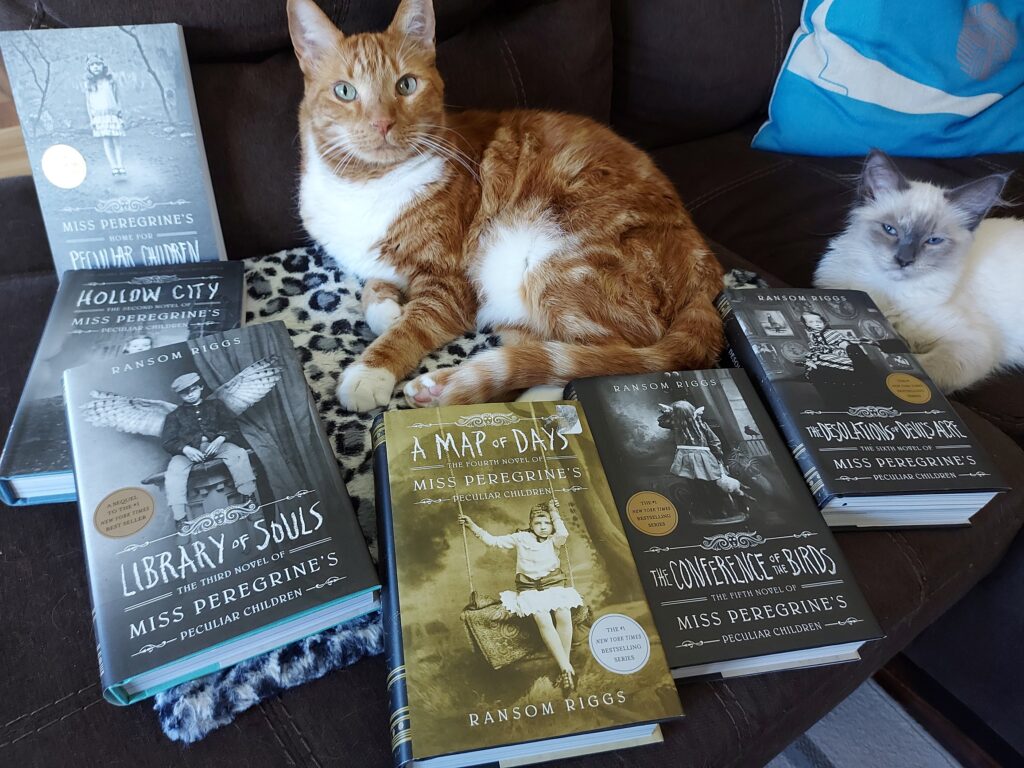Miss Peregrine’s Peculiar Children Series by Ransom Riggs

Miss Peregrine’s Peculiar Children is a YA series consisting of six novels based on an intriguing concept: a fantasy story designed around vintage photographs. Ransom Riggs uses 19th and early 20th century photographs that he collected to bring his characters to life and to create evocative settings. The first three novels in the series, Miss Peregrine’s Home for Peculiar Children, Hollow City and Library of Souls, were quite fascinating to read. The photographs that appear throughout the novels are eerie and some are just downright creepy; they compliment the story very well.
Miss Peregrine’s Peculiar Children is about a sixteen-year-old modern boy named Jacob Portman who discovers that his recently deceased grandfather lived a double-life involving some peculiar children. Jacob travels to Wales to the abandoned ruins of Miss Peregrine’s Home for Peculiar Children in search for answers about his grandfather’s past. He ends up travelling into the past, 1940 to be exact, and meets the peculiar children his grandfather knew. The children are peculiar because they have, well, peculiar abilities: one has a mouth in the back of her head; one is invisible; one has bees that live inside his body; one can reanimate the dead; etc. They live in a time loop of a certain day, September 3, 1940, that always ends with a bomb being dropped on Miss Peregrine’s house, before the loop is reset and the day begins again. They, and all the other peculiars in the world, live in time loops in order to keep themselves safe from the outside world where “normals” are afraid of them and think they are dangerous. If a peculiar spends more than 24 hours outside of a time loop and in the present, they will “age forward” and end up very, very old or very, very dead.
Jacob befriends the peculiar children and their guardian, Miss Peregrine, who is also an ymbryne (ymbrynes are a type of female peculiar who can turn into birds. They are the ones that create the time loops, and they govern the peculiar world). Jacob, who is a lonely teenager and misunderstood by even his own parents, wants so badly to fit into the peculiar world like his grandfather did, but he displays no outward sign of a peculiar ability. His peculiar ability (because of course he has one) becomes evident as he encounters hollowgasts, monstrous creatures who were once peculiars and who now hunt peculiars in order to consume their souls. Hollowgasts are invisible, which is what makes them especially dangerous, but Jacob’s peculiar ability is that he can sense when hollows are getting close, he can see them, and he eventually discovers that he can control them.
The hollows work for Caul Bentham, Miss Peregrine’s brother, who is sick of women, I mean ymbrynes, controlling everything and who wants to take over the peculiar world before taking over the normal world. The first three books are essentially about Jacob and the other peculiar children finding the courage to leave the time loop where they are safe, travel through the normal world and fight against Caul and his hollows.
The series would have ended on a good note if it had finished with Library of Souls, but Ransom Riggs, like most other authors of popular YA series, felt compelled to keep milking the peculiar children for all they were worth, I guess, and continued the series with A Map of Days, The Conference of the Birds and The Desolations of Devil’s Acre, and the series suffers for it.
By the time the series gets to book four, the neat vintage photographs begin to feel like a contrivance. The plot moves from the UK to America and shows another side of the peculiardom, which would have been interesting if most of the American peculiars were not unpleasant. Even Jacob and his peculiar friends are not as fun and likable as they were in the first three novels, so I really did not enjoy books four and five as much. Book six, The Desolations of Devil’s Acre, came out last year, but I did not feel compelled to buy it right away, and it took me even longer to get around to reading it. Maybe that was what I needed, a nice long break from the story and a reset, because once I started reading it, I found myself intrigued by the story and finished it very quickly. It was quite good; I just wish that for once a writer would deviate from reusing the villain that the main characters had already supposedly defeated.
Overall, I think the Miss Peregrine’s Peculiar Children series is worth reading. It is a unique story filled with even more unique characters and the photographs are a great addition, especially in the first three novels.